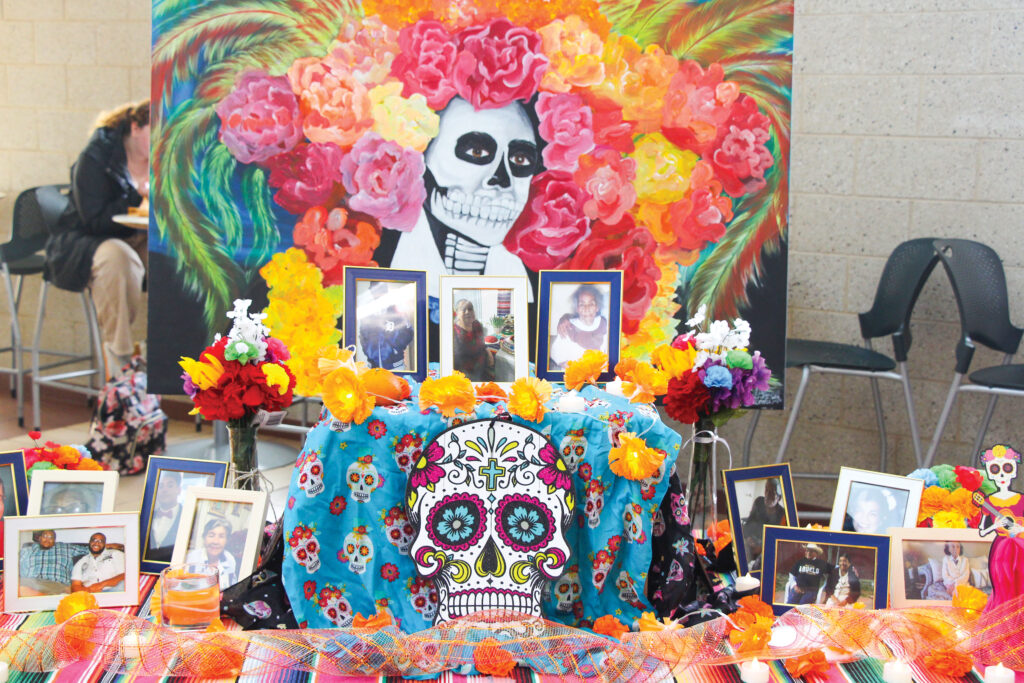The Hispanic/Latino Cultural Center partnered with Spanish for the Professions to celebrate Dia De Los Muertos, the Day of the Dead, and Dia de los Santos, All Saints Day, to celebrate and learn about the cultural importance of the holidays.

Thirty students passed through to celebrate the Day of the Dead, and All Saints Day, in the Interdisciplinary Resource Center building on Thursday, Oct. 31, from 10 a.m. – 2 p.m. The Day of the Dead celebration gave students the opportunity to have hot cocoa, pan dulce and tamales. Along with food and beverages, students painted sugar skulls and listened to music.
All Saints Day is celebrated on Nov. 1 and is specifically a celebration of life for young children who have passed. According to the University of New Mexico, the Day of the Dead is a primarily Mexican tradition that is celebrated on Nov. 2 to remember their loved ones who have passed away.
HLCC Director Sonia Treviño felt while the Day of the Dead can be sad because a relative has passed, it’s also a good way to celebrate the memories shared with that family member.
“Dia de los Muertos is a very traditional celebration of a relative or loved one,” Treviño said. “The passing of a loved one is sad when it happens, Dios de los Muertos was brought up in our culture to celebrate the life that they lived.”
Hispanic and Latino students who celebrate the Day of the Dead or All Saints Day also had the chance to put their loved one’s pictures on a community altar to celebrate and remember them.
This event is a way for students taking a language course, like Spanish, to learn about the culture surrounding the language outside of class walls.
Spanish associate professor Lucero Flores-Paez felt it is important that students taking a Spanish class should take the initiative to go to the cultural events surrounding Spanish-speaking people and cultures.

celebrations. Photo courtesy of Wiki Commons
“Most of the students taking language classes are not necessarily taking it for a language requirement, but for a culture requirement,” Florez-Paez said. “We incorporate a lot of culture in our classes, and this is culture outside the classroom since we are always teaching and learning outside the classroom.”
She also describes how the celebration of the dead is celebrated differently throughout Spanish-speaking countries and how the event does not only celebrate the Day of the Dead and All Saints Day. It also celebrates the other traditions in Hispanic-Latino culture and how different countries celebrate them.
“In Mexico, they go to the cemetery, they have music, food, carnivals and you can see all the marigold flowers,” Flores-Paez said. “Then you’re going to see some parts of Guatemala also having a similar celebration where they associate kites with the soul of the deceased coming to visit.”
French professor Daniel Noren had a table to educate students about how the Day of the Dead is celebrated in France and French-influenced places like New Orleans.
“In France, they get a huge three- or four-day holiday celebration out of it,” Noren said. “They put out chrysanthemums, and a lot of eating and drinking goes along with all the celebration festivities.”
The Day of the Dead and All Saints Day are not only celebrations of those specific holidays but also celebrations of the lives of loved ones across Hispanic-Latino Culture who are no longer with us. They educate those outside the culture and allow Hispanic-Latino students to celebrate their cultural holidays.
Another celebration for the Day of the Dead will be the Seventh Annual Day of the Dead Ball on Friday, Nov. 22 in the David L Eisler Center ballrooms from 6 – 9:30 p.m.
